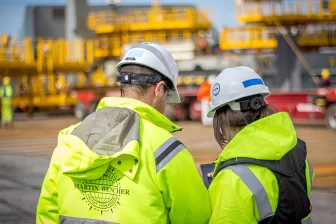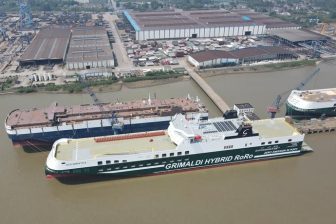
Jan De Nul orders crane simulator based on its newbuilds Voltaire and Les Alizés
Jan De Nul Group has ordered a high-end crane simulator covering its two next-gen offshore installation soon-to-be-delivered newbuilds, Voltaire and Les Alizés. The simulator will enable Jan De Nul to train its crews as it is based on real physics and the actual vessel models.
Crewmembers will be able to realistically simulate complex offshore installations in a safe environment, in the most severe conditions. The partner for the development of this simulator is the Norway-based company OSC (previously known as Offshore Simulator Centre).
The jack-up installation vessel Voltaire and the heavy lift vessel Les Alizés will be a serious size larger than their look-alikes currently available on the offshore installation market. Voltaire will be equipped with a 3,000-tonnes Leg Encircling Crane (LEC), the HLV Les Alizés with a 5,000-tonnes Tub Mounted Crane (TMC). Both vessels will be able to install future wind turbines at sea. Current offshore wind turbines go up to 15 MW, and very soon, because the industry is evolving at a rapid pace – are turbines up to 20 MW. As no vessels on the market currently can handle these giants, Jan De Nul expects its vessels to be the first on the market to handle the 20 MW units.
Tom Maes, manager Electrical and Automation department at Jan De Nul Group, said “This crane simulator will not only be producing extraordinary graphics and close-to-reality sensations like any random video game. The simulator will be based on real physics and the actual vessel models, offering a digital twin of both vessels and tools. In other words, a priceless engineering tool, fully at the service of our clients to advise them in their plans for the future.”
A Digital Twin and Multipurpose Training Device
This device will offer the chance to operators, deck crew, superintendents and bridge crew to train the specific skills and techniques required to operate the cranes, in a safe but realistic environment. It will allow them to prepare for different work situations, such as working in extreme weather conditions, with heavy loads and strict installation tolerances. Various mission equipment, such as the motion-compensated pile gripper, including the communication and interactions between the different persons involved in lifting procedures, will also be a key aspect of the training package.
On the other hand, this simulator will be a priceless tool for Jan De Nul to use during engineering and initial feasibility studies for projects and tenders. Thanks to the next generation advanced dynamic and hydrodynamic models incorporated in the software, this training device will be a digital full-scale replica of the real set-up on board, including a fully digital environment where future or existing project scenarios can be uploaded, tested and rehearsed well in advance and in a completely safe environment.



